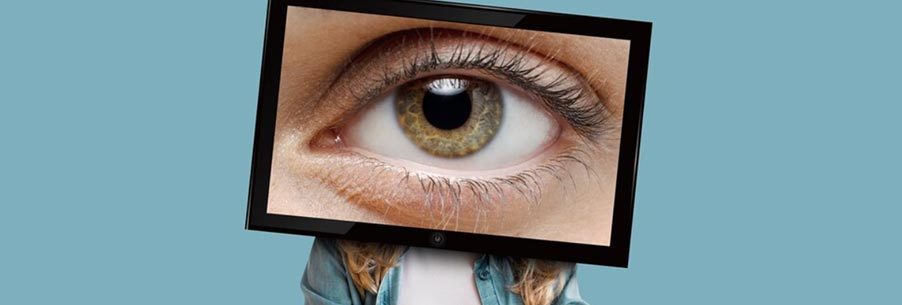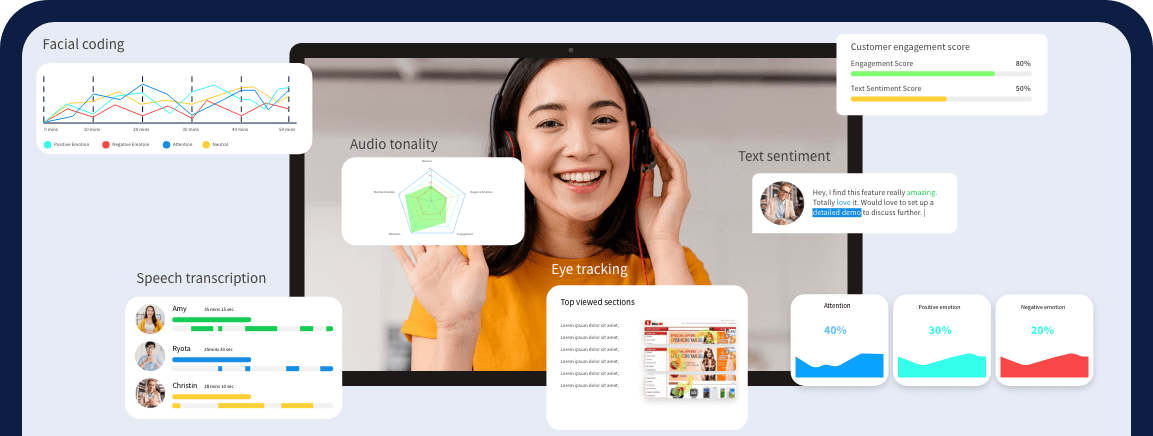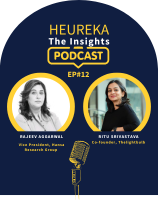Eye Tracking
Eye Tracking Technology
Collecting detailed customer data has been a mandate for businesses to understand customer intentions. Marketers stack their marketing arsenal with multiple tools and platforms to analyze customer engagements and their behavior across touchpoints. Yet, achieving a healthy conversion rate remains elusive for most businesses.
Lower conversions are often related to the communication that the audience is interacting with. It is known that marketing messages according to the audience’s interests, needs, and preferences can improve engagement and, eventually, conversion. However, even with strong communications, conversions can dip. This is because marketers still fail to effectively capture the audience’s psyche while interacting with the message. The “Eye Tracking” technology can solve the issue efficiently by understanding whether the audience is genuinely interested in your brand or is it another general piece of promotion.
Eye Tracking: Introduction
Using sensors that track eye movement can help brands to detect the user presence and what they are looking at in real-time and gather immense information regarding user perception of the product. It considers several parameters such as pupil position, gaze point, and gaze vector of the eyes to help businesses map the user emotions towards the offerings. Consequently, marketers can design their marketing campaigns to be more attractive to the users and help them make a purchase decision sooner.
Types of eye tracking
- The attached technique collects data using a special device directly placed around the eye, such as a contact lens.
- The electric potential method uses electricity via electrodes placed around the eyes.
- Optical tracking uses reflected light and videos to determine eye movement.
Irrespective of the techniques used, eye tracking always tries to identify a few common aspects. It first determines the focus point and focal distance of the eyes and their direction. It also gathers information about eye movement during the head turn and tilt, the time spent on a particular point, and how fast they move during the process. Depending on the data collected, the tracking accuracy is processed.
How does eye tracking work?
The pupil center and corneal reflection are closely related to the iris position. However, infrared lights allow a clear distinction between the iris and the pupil so as not to cause any distraction during the tacking process.
Eye tracking Mechanism
- Head-Stabilized Eye Tracking:
This type of system requires a method to restrict the participant's head movements, usually through a bite bar or chinrest. It is commonly used in high-fidelity research in neurophysiology or vision experiments where accuracy and precision precede participant comfort. Head stabilization may also be necessary with technologies like fMRI or MEG that immobilize the head.
These systems are employed for three main reasons: to enhance accuracy and precision by eliminating head-movement artifacts and noise, provide a consistent visual experience for all participants, and complement other technologies requiring head stabilization. Head-stabilized eye tracking systems offer a level of precision that other systems cannot achieve. It uses a high-resolution camera that can take a closer image of the eye without needing to adjust for head movements. They can also achieve higher sample rates, allowing for faster eye movement analysis. These systems can be either monocular or binocular. - Remote eye-tracking:
Remote eye-tracking systems don't require physical contact with the participant and instead use a camera positioned at a distance to track eye movements. The camera adjusts its view to account for head movements and uses pupil center and cornea reflection to track eye position and head orientation. Typically, the camera and IR source are positioned below the display, and the camera can be set in front of or attached to the screen or embedded in a device like a laptop or a kiosk. Remote systems have a working area called a "head box" and can only track eye movements within a defined "calibration plane," usually the computer screen. If the participant looks outside this area, tracking is temporarily disrupted, but an excellent remote system can quickly reacquire the eyes once they're back in range. Remote systems are commonly used for screen-based experiments or interactions and gaze-contingent interfaces like assistive technology or gaming laptops. - Mobile Eye-Tracking:
Mobile eye tracking, also known as head-mounted eye tracking, involves a device worn by the participant, such as eye-tracking glasses or a headband. This system requires a camera or mirror to be positioned in the optical path of one or both eyes and an additional camera to record the scene or field of view. Gaze tracking in head-mounted systems is done with the entire field of view, making it useful for real-world experiments in sports, driving, social communication, mobile device testing, and more. The latest mobile systems are untethered, allowing for more realistic experiments during vehicle use, motor control, sports training, and store-shelf shopping. Head-mounted systems built into glasses are generally more comfortable, less invasive, and can be worn with other technologies like EEG.
The use of mobile eye tracking enables studies in perception, communication, and other fields to be conducted in naturalistic and realistic contexts. In human factors and usability research, head-mounted eye tracking is often used to study interaction in industrial settings or when using real-world objects. For example, a car company can learn how changes to the design of a car's dashboard or sightlines can affect driver perception. An industrial engineer can study attention-based safety hazards in a factory or warehouse. In contrast, a usability engineer can check gaze during a wayfinding test for informational signs in an airport. Mobile eye-tracking systems are also employed to analyze the user experience of smartphone applications. Mobile eye-tracking systems are typically binocular, as tracking only one eye can result in parallax error, which affects the calculation of gaze data at depth due to the angle between the eyes and the scene camera. - Integrated or Embedded Systems:
Eye-tracking devices can be integrated into various types of technology, including medical products, consumer electronics, and vehicle dashboards. In recent years, there has been an increase in the integration of eye-tracking devices into virtual and augmented reality devices for research and control purposes. One use of eye tracking in VR is foveated rendering. Higher-quality graphics are rendered at the point of gaze and lower quality in the periphery to save processing power. This requires fast sample rates and real-time data transmission. Eye tracking can also provide an intuitive control method for menus in AR and VR without a mouse or keyboard.
Eye tracking vs. Gaze tracking
Despite the difference, the eye tracker gathers insights from analyzing various gazing patterns. It can record information like gaze duration on a screen, head movements, and other details for analysis but is not used for communications. Rather, the primary purpose here is to collect information for research purposes, which can be used to treat various medical ailments like neurological issues.
Yet, this information can also help fine-tune the gaze technique parameters and derive intent-driven insights into customer preferences. Further, depending on other parameters like eye movement, realizing the impact of the communication the users are watching can be efficient.

Eye tracking for visual attention
Eye tracking provides numerical data about where the gaze is, including the coordinates in the x/y plane and confidence levels, which can be used to compute metrics like fixation and revisits. Eye tracking can capture everyday situations and processes that rely on visual attention, such as playing video games, reading, and buying behavior. Psychology and cognitive science experiments can be designed to study these contexts and analyze relationships between attention, performance, and eye movement. Eye-tracking technology can provide valuable insights into these attention-related functions across various psychological contexts across the target audience.

Eye-tracking data presentation
Eye tracking is a technology that can quickly and easily analyze a person's viewing patterns to understand how they react to marketing tools. It allows researchers to intercept a person's gaze before they can control their eye movements and provides various metrics and statistics such as heatmaps, gaze plots, and fixation counts. However, even the most well-planned neuromarketing research may fail in real-life conditions. Testing the logic and equipment with a few participants is essential before launching a full-scale campaign analysis.
To ensure proper gaze mapping, it's crucial to calibrate the eye-tracking equipment correctly. It's also important to remember that participants may look beyond the testing object, so it's necessary to consider screen resolution and size. Heatmaps are a popular tool to analyze gaze patterns because they provide easy-to-understand visualizations of where users looked and which areas attracted their attention the most. However, supporting heatmaps with other eye-tracking metrics is recommended to identify outliers affecting data quality.
Central fixation bias is another common tendency for participants to look at the center of the image, which can lead to misleading results if the tested object is within this area. To mitigate this bias, it's best to analyze fixations of gaze that occur 1-2 seconds after the initial demonstration of the tested image and place the tested object outside the screen center. Additionally, researchers should avoid putting too many areas of interest on a page or tested thing, as eye trackers have a margin of error that can compromise gaze-catching accuracy.
Using fundamental eye-tracking tools, one can determine where, when, and what people are looking at and what they may miss. However, it is necessary to go beyond the basics to gain a deeper understanding of the subject's response.
One such method is to measure pupil size or dilation, which can provide insight into emotional engagement and cognitive workload. It is essential to note that pupil responses alone cannot indicate whether the emotional response is positive or negative.
Eye trackers can also measure the distance between the respondent and the screen and their relative position. It can provide information on approach-avoidance behavior, but interpreting the data is application-specific.
Ocular vergence, or the movement of the left and right eyes, can be measured independently, indicating whether the subject is focusing on something close or far away. Divergence, or when the eyes move apart, can indicate a loss of focus or concentration.
Finally, monitoring blinks can provide information on cognitive workload. A low frequency of blinks may indicate higher concentration levels, while a high frequency may indicate drowsiness and lower levels of focus.
Use cases and applications of eye-tracking
Medical Research
Gaming Research
Simulation
Sports
Virtual Reality
Challenges of eye tracking
Calibration
User variability
Environmental factors
Cost
Ethical concerns
Limited application
Limited accuracy
Direct interviews analysis
Request a Live Demo!
See how Facial Coding can
help your business
Book your slot now!
Other technologies similar to facial coding
Latest from our Resources
Using Emotion AI to Spot and Smooth Out Digital Experience Pain Points
Using Emotion AI to Spot and Smooth Out Digital Experience Pain Points Imagine you own a high-end retail store. A customer walks in, looks at a product, scowls in confusion, sighs loudly, and walks out. You saw it happen. You know exactly why you lost the
Read MoreWhy E-Commerce Needs Data-Driven Customer Journey Maps
Why E-Commerce Needs Data-Driven Customer Journey Maps Walk into any E-commerce Director’s office, and you will likely see it: The
Read nowHow Facial Coding Helps Brands Test Audience Reactions to TV Promos and Long-Format Ads
How Facial Coding Helps Brands Test Audience Reactions to TV Promos and Long-Format Ads In the world of advertising, the stakes have never
Read now



